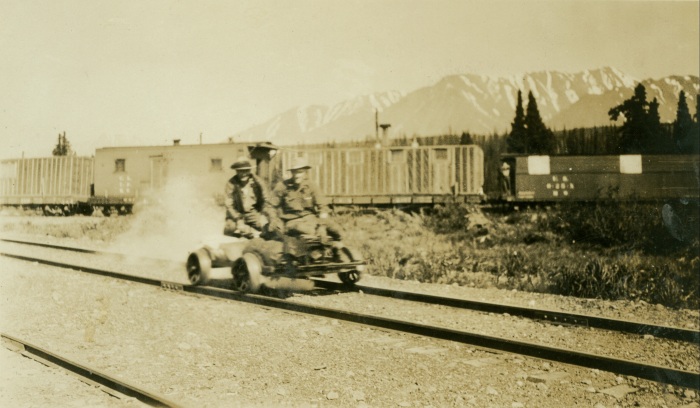
A gasoline powered velocipede underway near a railroad siding on the Anchorage to Fairbanks railway in 1923. Photo by Mr. Floyd Risvold/USC&GC, in the public domain.
In August 1901, E. T. Barnette was traveling up the Tanana River on the Lavelle Young with a boatload of supplies bound for Tanacross to set up a trading center on a well-used gold-rush trail. Unable to negotiate some rapids, Captain Charles Adams turned into the Chena River to try to bypass them but got stuck on the Chena’s silt-laden sandbars. Adams refused to go any farther, and Barnette refused to turn back, leaving the two men as stuck as the boat. The Fairbanks strike differed markedly from the shiny shores of the Klondike and the golden sands of Nome—this gold was buried under frozen muck anywhere from 8 to 200 feet deep.Peering through field glasses from a distant hill, Felice Pedroni (Felix Pedro, as he’s remembered) watched the boat’s progress—or lack thereof—by the smoke from its stacks. A mountain man and prospector, Pedro had been looking for gold in the huge wilderness north of the Tanana and Chena Rivers for several years and had found signs of color on some creeks near where he stood watching the steamer. However, running low on provisions, he was facing a several-hundred-mile roundtrip to Circle to restock, unless . . .Meanwhile, Captain Adams was unceremoniously dumping Barnette, his wife, and their goods on the shore. “We cut some spruce and helped him get his freight off,” Adams recalled 30 years later. “We left Barnette furious. His wife was weeping on the bank.” They were standing directly in front of the present site of downtown Fairbanks. That’s when Pedro showed up, quietly informed Barnette of his prospect, and bought a winter’s worth of supplies. Back at his promising creek, Pedro finally hit pay dirt.
News of the strike traveled far and fast. Miners abandoned the played-out Klondike and Nome and headed for the tiny outpost on the Chena River, named after Illinois Senator Charles Fairbanks, who soon became vice president under Teddy Roosevelt. Unfortunately, Barnette wasn’t content with his good fortune of owning most of the town site of rich little Fairbanks. In 1911, he was tried for embezzling funds from his own Washington-Alaska Bank. Though he was acquitted, he left town with his family, never to return. His wife divorced him in 1920 in San Francisco; where he went from there, and when or how he died, are complete mysteries. Only one clear photograph of his face survives today: Barnette standing in a line with several other early Fairbanks bankers. But when the photo was found, old-timers were hard-pressed to identify which one was the town father. In fact, a discrepancy even exists over his first name. In E. T. Barnette, Terrence Cole calls him “Elbridge,” while The $200 Million Gold Rush Town, by Jo Anne Wold, remembers him as “Eldridge,” and the city fathers commemorated him by naming an elementary school Ebenezer T. Barnette. Whatever his name, possibly no man embodies the boom-bust character of Fairbanks better than its founder, E. T. Barnette.
The Fairbanks strike differed markedly from the shiny shores of the Klondike and the golden sands of Nome—this gold was buried under frozen muck anywhere from 8 to 200 feet deep. Fortune hunters quickly became discouraged and left, which rendered Fairbanks’ boom much less explosive than Dawson’s or Nome’s. Even determined miners eventually reached the limits of both their endurance and the primitive placer-mining technology. After fires and floods, by 1913, when the road from Valdez to Fairbanks was completed, the town was in the midst of a serious bust cycle. But in 1923 the Alaska Railroad reached Fairbanks from Seward and Anchorage, which inaugurated the real Golden Age. Major mining corporations freighted up and installed large dredges to uncover the gold, and eventually $200 million worth was pulled from the surrounding area. When the Alaska Highway was pushed through to Delta from Canada in 1942, connecting the Richardson Highway to the outside world, the city’s future was assured.
Only one word can really be applied to Fairbanks in the 1970s: boomtown. The Prudhoe Bay oil discovery of 1968 led to a massive influx of pipeline workers and hangers- on. Suddenly demand far exceeded supply, making it a seller’s market for everything from canned food to cocaine, from housing to hookers. So many people poured in with dreams of big bucks that officials took out ads in Lower 48 newspapers telling everyone to stay away. Only half the job-seekers ever got hired, and the lines at the bank were only exceeded in length by those at the unemployment office. Fairbanks today is a vastly different place from the pipeline era, with an economy that prospers on the university and military payroll, on the summer tourist season, as a supply center for the bush, on construction, and on the nearby Fort Knox gold mine.
Excerpted from the Tenth Edition of Moon Alaska.